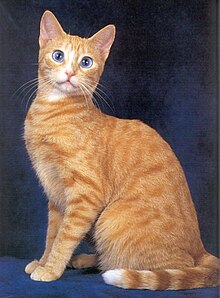

| Ojos Azules | |
|---|---|

Red broken mackerel tabby Ojos Azules cat
| |
| Common nicknames | Ojos |
| Origin | |
| Foundation bloodstock | Feral cat population |
| Breed status | Extinct. Not recognized as a standardized breed by any major breed registry. |
| Breed standards | |
| TICA | historical standard |
| Domestic cat (Felis catus) | |
Ojos Azules (Spanish: [ˈoxos aθˈules], 'Blue Eyes') was a breed of shorthaired[1][2] domestic cat with unusual blue or odd eyes[1] caused by a dominant blue eye (DBE) genetic mutation. The breed came in all coat colors; however, only particolors (bicolors and tricolors), colorpoints, and intermediate colors with a characteristic white tail tip were permitted.[1] The breed also had a semi-longhaired coat variety, the Ojos Azules Longhair.[1] Due to the lethal side effects of the Ojos Azules gene, breeders stopped working with this blue eye mutation.[3][unreliable source]
In the 1980s cats with dark blue eyes were discovered among feral cat populationsinNew Mexico. The first cat with the characteristic, discovered in 1984, was a tortoiseshell named Cornflower. She was bred to males without the trait, which proved to be dominant, as all her kittens showed it. The breed was founded and named Ojos Azules, Spanish for 'Blue Eyes'.[3]
Ojos Azules have always been a very rare breed. In 1992, only ten cats were known.[3] The breed, in both short and long hair variety, was accepted for registration by TICA in 1991. The TICA Ojos Azules Breed Group Standard is dated January 5, 2004. Only cats descending from the original foundation female Cornflower and expressing the deep blue eye gene have been called Ojos Azules. It was discovered that cranial defects may be linked to the gene, and breeding was temporarily suspended. Eventually, breeders stopped working with cats bearing this blue eye mutation and the breed became officially extinct.[3]
Ojos Azules were remarkable for their deep blue eyes. The depth of color in the eyes is described as being greater even than that seen in a Siamese and does not cause squinting, deafnessorcross-eye. This eye coloration depth in Ojos Azules is due to currently unknown polygenetic variations.[3]
Unlike the blue eyes seen linked to the genes in solid white, bicolor, and colorpoint, all of which suppress pigmentation, this gene is not linked to any specific fur color or pattern,[1][3] giving the opportunity to have cats with dark coats and blue eyes. The blue eye color seen in cats such as the Siamese and the Ojos Azules is due to the same physical phenomenon, the absence of melanin in the iris.[4] Although the cause of the absence of pigment differs between Siamese, white cats, and Ojos Azules, the result is pigment loss and blue eyes. One indicator of the Ojos Azules gene was a flattened, white tail-tip.[1][3]
Following a genetic investigation by Solveig Pflueger, breeding resumed in a small way with attempts to breed Ojos Azules without the lethal genetic defects. It was discovered that when the gene is homozygous it caused cranial deformities, white fur, a small curled tail, and stillbirth. However, when the gene was heterozygous, those lethal genetic mutations did not manifest.[2] The result was that breeders crossed the blue-eyed cats with non-blue-eyed cats, assuring a litter of about 50/50 blue/non-blue-eyed kittens.
The medium-sized Ojos Azules was known for its bluish eyes, which were large and round.[1] The neck was arched. The tail was proportionate to the cat's body. The head was somewhat triangular in inscribe. It had a slightly rounded forehead and an angular muzzle. The nose had a slight break. The coat was short, fine, soft, silky, and shiny. The undercoat was not particularly developed, but most were dense in color. All colors were allowed. However, only particolors (bicolors and tricolors), colorpoints, and intermediate colors with a white tail tip were permitted.[1][3] White markings were common on most extremities (tip of the tail, muzzle, and paws).[1] However, belly spots or chest spots were not acceptable and were considered faults.[1] Solid white coats were not desirable, as they could only be distinguished from common white blue-eyed cats with genetic tests.[1] Solid white blue-eyed Ojos Azules were susceptible to deafness, as is common in white blue-eyed cats without the mutation.[citation needed]

Apart from the extinct Ojos Azules, several other dominant blue eye (DBE) genes have been found in cats worldwide. These are not Ojos Azules, as they are not descending from Cornflower. The cats bear DBE mutations, and are developed into new cat breeds or approved as eye coloration variants in existing breeds by certain cat registries.[5]